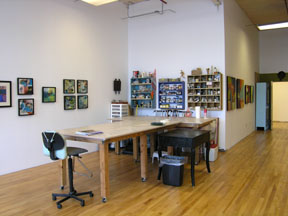tap, tap, tap, etc.
That's me making this work. Wouldn't you like to be my studio neighbor? (I did some work with tacks similar to this years back when I lived in an artists' building, and my neighbor was ready to tear her hair out - or maybe it was my hair she was after. Luckily I'm now in a work-only building.)
Note: Click on the images to enlarge them.
 |
| Bandeau Green, wax-based assemblage on joined birch panels, 24"H x 42"W x 1.75"D |
These works are part of the continuing Running Stitch Series that I showed you earlier this month. They are composed of materials such as book covers cut in strips, pieces of treated metal, dipped book pages, rubber, various textural pieces and painted matboard cut into strips. After I attach these materials to the birch panels with tacks (thus the tap, tap, tap), I paint encaustic between and over the strips. I fuse the encaustic with a heated tool (a shoe) as the final step in the process.
 |
| Bandito, 24" x 24" x 1.75", on one birch panel |
 |
| Closeup of Bandito |
And, finally, breaking out of the green mode, I've moved on to red.
 |
| Untitled Red, diptych 24"H x 42"W x 1.75"D (a less than perfect photo) |
 |
| A side view of the piece showing more surface texture |
 |
| Closeup of completed red piece. Can you identify the rounded rectangle shapes? |
As I said above, the final step in making this work is to add the encaustic paint on top after all the construction is done. In the image below, I show you the difference between a panel with and a panel without the final coat.
And finally, here is an image of some of the painted matboard I used. I first painted this (archival) matboard with Evans Encaustic burnt sienna Holy Grail and then painted on a coat of red and/or orange encaustic. I fused it with a heat gun and let it cool before cutting it into strips. The pinkish-brownish strips in this photo were made from matboard painted with a grainy ink, let dry and then overpainted with very thin pink encaustic. (I am going to write a rave review a little later about Evans Encaustic holy grail encaustic gesso now available in colors. It is fabulous!)
 |
| Painted matboard pieces |









11 comments:
Love the new work!!
These are wonderful! Thank you! The horizontality and then the lining up of the tacks vertically is all very soothing and reassuring. I could VERY easily live with one of these in my home. Very happily.
Q: --> "I fuse the encaustic with a heated tool (a shoe) as the final step in the process." Sounds tedious, what with all the texture. Why not a torch? Because of the risk of catching the edges of some of the materials on fire? Just curious.
Again, thank you for making these. Heaven!!!!
Jan
Nancy, this is fabulous work!
Gorgeous!
These are wonderful pieces and I am enjoying your reference to a "running stitch!. Tap Away.
Fabulous Nancy! Thank you for the wonderful Saturday afternoon artsy football-reprieve. Congratulations on your new work-
Thanks to everyone for your enthusiastic comments! I very much appreciate the response.
In reply to the question posed by Jan @Observe Closely, I fuse with the heated shoe tool because I want to control the wax to a greater extent than is possible with either a heat gun or torch. That is, I don't want it to melt except in the channels that I have made between the strips. Remember that the surface of the strips is already painted with or dipped in encaustic. If I used a torch or heat gun, everything would melt and run together. I want to leave the wax in place because I have already considered the color and fused the surface when I prepared the matboard that became strips. Also, as you surmise, there is the danger of igniting flammable things such as the frayed edges of book covers and pieces of cardboard.
My other reason for using the heated tool is that I can scribe marks into the wax and make more texture. With the shoe, this happens as part of the fusing process rather than as another step as when using a heat gun or torch.
I became a heated tool afficionado when I took the course Francisco Benitez ran at the last encaustic conference. He showed us the techniques used by the Fayum portrait painters and other ancient encaustic painters. These painters knew what they were doing. On the other hand, I wouldn't like to paint a whole statue with this method.
Fabulous!!!!
This new work is indeed fabulous. I'd say it's groundbreaking for you. I hope you will apply for all the grants available to you, because surely there's a grantor out there who would jump you support this work.
I agree with Joanne. Grant or good publicity- get this work seen by tons of people. Very compelling, dense, intriguing work!
Pam, Joanne and Hylla - You guys are great to comment so enthusiastically! I would like to have people see it in the flesh and getting a chunk of moola would be a very good thing. I'm working on it and will let you know how it goes.
Post a Comment